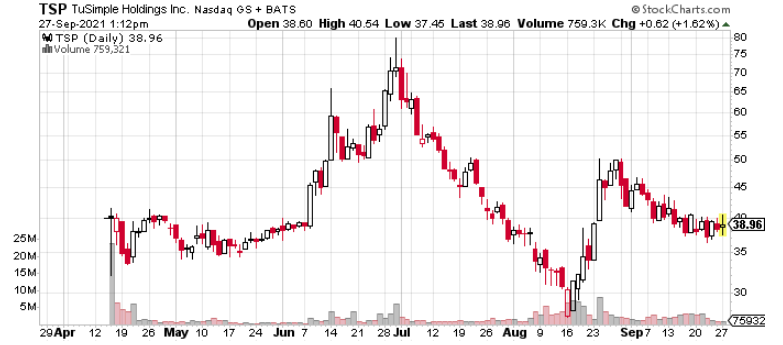How can two investors own stakes in the same company yet one loses money on their investment while the other books a nice double-digit gain?
It all comes down to one of the most important fundamental aspects of investing… You MUST time your entry and exit points properly.
And this applies to all stocks, whether you’re trading super-volatile meme stocks like AMC Entertainment Holdings Inc. (NYSE:AMC), a long-standing Fortune 500 company like Microsoft Inc. (NASDAQ: MSFT), a tiny yet innovative tech startup like TuSimple Holdings Inc. (NASDAQ: TSP), or even a little-known biotech creating the next “wonder drug.”
But if you master this simple concept or follow along with the traders and investment experts (like myself, Keith Kohl, Christian DeHaemer, Jeff Siegel, and Luke Sweeney) who have mastered this and many other important aspects of investing for outsized returns, you can beat the S&P 500’s, the Dow’s, and the Nasdaq’s average returns every year.
That’s the secret sauce to becoming a successful investor.
Now, let me show you with a few real-world examples why knowing the best time to buy a stock and the best time to sell will change the way you invest and put a lot more cash in your pocket.
Timing Is Everything When It Comes to Investing
Let’s start with everybody’s favorite meme stock, AMC. If they entered the stock back in February or March 2021, investors who gambled on this company made a killing.
The large majority of these investors had specific information, were galvanized by a common cause to squeeze the hedge funds, and were connected via social media, giving them a unique insight into when to enter this trade, even when the fundamentals behind the company were terrible. By June, the r/WallStreetBets mob had pushed AMC’s share value up over $50 per share, representing roughly a 588% gain for those who claimed shares six–seven months ago.
Unfortunately, many other investors missed the boat on this trade and latched on late, hoping another surge was coming, but that surge never came. AMC’s average daily volume for the year is right around 87 million shares traded a day. As AMC share value peaked in early June, so did daily volume. When AMC was trading as high as $72 intraday on June 2, 2021, buy volume also peaked, hitting 766 million shares traded. This means millions of investors, fueled by the fear of missing out (FOMO), bought AMC shares in June. Ever since, those millions of latecomers have lost money. Shares today are trading at around $39 per share, at a volume of about 19 million.

But what about Microsoft? Surely if there’s a stock you can buy and basically forget about until next year, it would be MSFT.
Well, not exactly. Now, don’t get me wrong; I think anyone who is a serious investor should have a stake in Microsoft. It’s an investment you can make and hold onto for years and years, with sustained returns that will usually beat the pants off the major indexes’ returns each year. But sometimes tech stocks pull back — even MSFT shares — which is why your entry and eventual exit are still extremely important… even for stocks we may sit on for years.
If you bought MSFT shares in 2010 — assuming you still hold them — it would have taken you about five years to see any significant returns. In the early 2000s, MSFT was a solid but stagnant company that did a few very important things well. However, the company still hadn’t figured out the secret to becoming an exciting tech company like its rivals Apple (NASDAQ: AAPL) and Amazon (NASDAQ: AMZN).
However, around 2015, corporate leadership began to change, and a fresh and innovative new CEO, Satya Nadella, was the spark needed to send shares off and running. Since 2015, Nadella has turned MSFT into one of the most important cloud service companies on the planet. He has grown the company’s gaming sector significantly and turned many of MSFT’s most well-known products into subscription services. Investors loved these changes, and if you saw the writing on the wall like many of us did, you knew the years between 2015 and 2018 were great entry points. Shares today now trade a shade under $300 each — a huge increase from the $25–$50 range they sat in from 2000–2015.

Electric vehicle startups hit the market hard in 2021, and investors so far have shown a healthy appetite for these EV stocks. Tesla Inc. (NASDAQ: TSLA) of course is the gold standard for EV investment, but with the right timing, investors could have also banked significant returns on one of the only electric semi-truck makers on the market. For starters, and as I have written to you before, buying a hot initial public offering isn’t actually the way to buy a stock at ground-floor pricing. In fact, technically speaking, when you buy a highly anticipated IPO, the price you pay at market upon debut is actually the current top for the stock.
Pre-IPO pricing is what previous owners who claim huge IPO gains are actually doing. Anyone who bought Airbnb on its IPO date knows exactly what I’m talking about. Typically, the best time to buy an IPO is three–six months after the IPO date. This is because many pre-IPO shareholders are contractually obligated to hold their shares until their “lockup date,” which is typically three–six months after the IPO date. This often causes a dilution of share value, but if a company has strong fundamentals, this is the best time to buy into a new company.

That’s why investors who waited or took my advice to buy TuSimple’s dip in late April made much more money than the IPO buyers did, provided they recognized when the trade had become overheated and sold in late June or early July. Of course, with shares depressed and now trading in a range, if you missed this first surge, the technicals indicate round two in TuSimple is about to manifest.
Buy Low and Sell High: How to Know When to Enter and Exit Your Positions
How do I know when to enter and exit a stock position?
This is one of the most important questions any investor or trader needs to ask themselves, their broker, or an expert analyst — like any of the analysts here at Energy and Capital. Of course, the answer is far more complicated than you might expect. Each sector, from biotech to raw materials, trades differently. Different catalysts move the needle in different ways, and one news headline may tank one stock while sending another one surging.
I won’t lie to you. It has taken me nearly a decade to learn the finer nuances of each sector and the specific types of catalyst that will move a stock on any given day. And if I take this into consideration, one thing becomes clear: Most folks like you simply don’t have the time it takes to pore over SEC filings and press releases to find these unique catalysts. Truth be told, your best bet is to take the good advice of someone you trust and know has the time to conduct the necessary research to identify the best time to buy into a stock.
Take, for instance, my colleague Jeff Siegel’s approach to timing his entry dates.
Using Public Stock Offerings to Get Great Stocks at Supreme Discounts
A public offering is the sale of equity shares or other financial instruments such as bonds to the public in order to raise capital.
Generally speaking, these events temporarily dilute the value of a company’s stock, and many times investors look at public offerings as a reason to sell their position. But that rule only applies to some sectors. In other sectors like in tech and biotech, where research and development costs are through the roof, public offerings are more the norm and offer savvy, fast-moving investors the chance to get in on great young companies at significant discounts to their true value.
For example, say tiny biotech company XYZ is trading for $1.00, but due to the extensive cost of conducting its Phase 2 FDA trials it does a public stock offering at $0.70. Trading volume spikes on the buy side, giving the company a much-needed infusion of capital and new investors a chance to buy shares at a big discount. Sure, in the near term in this situation, the stock will likely fall 20%–30%, but because its true value is still $1.00, it will likely return to that price point once the dilution event is over.
Simply put, Jeff has discovered one of the best ways to show readers how to buy the dip on tiny companies with huge upside potential.
But don’t just take my word for it. Stay tuned for a special alert on Thursday explaining all the details.
To your wealth,

Sean McCloskey
Editor, Energy and Capital
After spending 10 years in the consumer tech reporting and educational publishing industries, Sean has since redevoted himself to one of his original passions: identifying and cashing in on the most lucrative opportunities the market has to offer. As the former managing editor of multiple investment newsletters, he's covered virtually every sector of the market, ranging from energy and tech to gold and cannabis. Over the years, Sean has offered his followers the chance to score numerous triple-digit gains, and today he continues his mission to deliver followers the best chance to score big wins on Wall Street and beyond as an editor for Energy and Capital.

 @TheRL_McCloskey on Twitter
@TheRL_McCloskey on Twitter